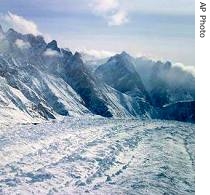2007年VOA标准英语-US Scientists Say Pollution Accelerates Melting
时间:2019-01-04 作者:英语课 分类:2007年VOA标准英语(八月)
Hong Kong
05 August 2007

An aerial view of the Siachen Glacier, northwest of Jammu, India
U.S. scientists say clouds of man-made haze 2 that blanket southern and eastern Asia are helping 3 accelerate the melting of the Himalayan glaciers 4. VOA's Heda Bayron reports from our Asia News Center in Hong Kong on the effect of these so-called "brown clouds" on the region's climate.
A team from the Scripps Institution of Oceanography in California used unmanned aircraft to measure heat in the atmosphere high above the Indian Ocean, a part of Asia often blanketed by "brown clouds" of man-made pollution.
Brown clouds are known to cool the land or sea below them because they trap sunlight, not allowing it through to the earth below. Until now, however, little has been known about the clouds' effect on the air immediately around them.
The Scripps team found that the brown clouds increased the heat of the air around them by around 50 percent. The team says the clouds have contributed roughly half of the temperature increase that has been blamed for the melting of the Himalayan glaciers.
"What we discovered from our measurement was the brown cloud was absorbing a lot of sunlight and was contributing to heating of the air," said V. Ramanathan, the chief scientist of the research team. "We put this data in a climate model and that model suggested that the warm air was contributing to glacial melt."
Brown clouds are made up of tiny particles called aerosols 5 that come from, among other things, forest fires, vehicle and industrial emissions 6, and the burning of wood and cow dung for cooking that is common in many households in developing Asia.
"It's basically the smoke. The smoke carries these particles, and the atmospheric 7 winds transport it so that we see [in] satellite data the brown cloud covering [the] entire South Asia and East Asia region and go over the ocean so that they intercept 8 sunlight and modify the climate," added Ramanathan.
Experts say the loss of the Himalayan glaciers could mean water shortages for millions in Asia. The glaciers of the Tibetan plateau are the main source of the region's major rivers such as China's Yellow River, Southeast Asia's Mekong and India's Ganges.
In May, Greenpeace in China said Mount Everest was heating up at triple the world's average. Some scientists say at the current rate of warming, the Himalayan glaciers could disappear by 2035.
Ramanathan says one way to reduce brown clouds is to start using solar-powered cookers in millions of Asian households.
- The glacier calved a large iceberg.冰河崩解而形成一个大冰山。
- The upper surface of glacier is riven by crevasses.冰川的上表面已裂成冰隙。
- I couldn't see her through the haze of smoke.在烟雾弥漫中,我看不见她。
- He often lives in a haze of whisky.他常常是在威士忌的懵懂醉意中度过的。
- The poor children regularly pony up for a second helping of my hamburger. 那些可怜的孩子们总是要求我把我的汉堡包再给他们一份。
- By doing this, they may at times be helping to restore competition. 这样一来, 他在某些时候,有助于竞争的加强。
- Glaciers gouged out valleys from the hills. 冰川把丘陵地带冲出一条条山谷。
- It has ice and snow glaciers, rainforests and beautiful mountains. 既有冰川,又有雨林和秀丽的山峰。 来自英语晨读30分(高一)
- Aerosols are present throughout the atmosphere. 气溶胶存在于整个大气层。 来自辞典例句
- Deodorants are available as aerosols or roll-ons. 除臭剂有喷雾装或滚抹装。 来自辞典例句
- Most scientists accept that climate change is linked to carbon emissions. 大多数科学家都相信气候变化与排放的含碳气体有关。
- Dangerous emissions radiate from plutonium. 危险的辐射物从钚放散出来。
- Sea surface temperatures and atmospheric circulation are strongly coupled.海洋表面温度与大气环流是密切相关的。
- Clouds return radiant energy to the surface primarily via the atmospheric window.云主要通过大气窗区向地表辐射能量。